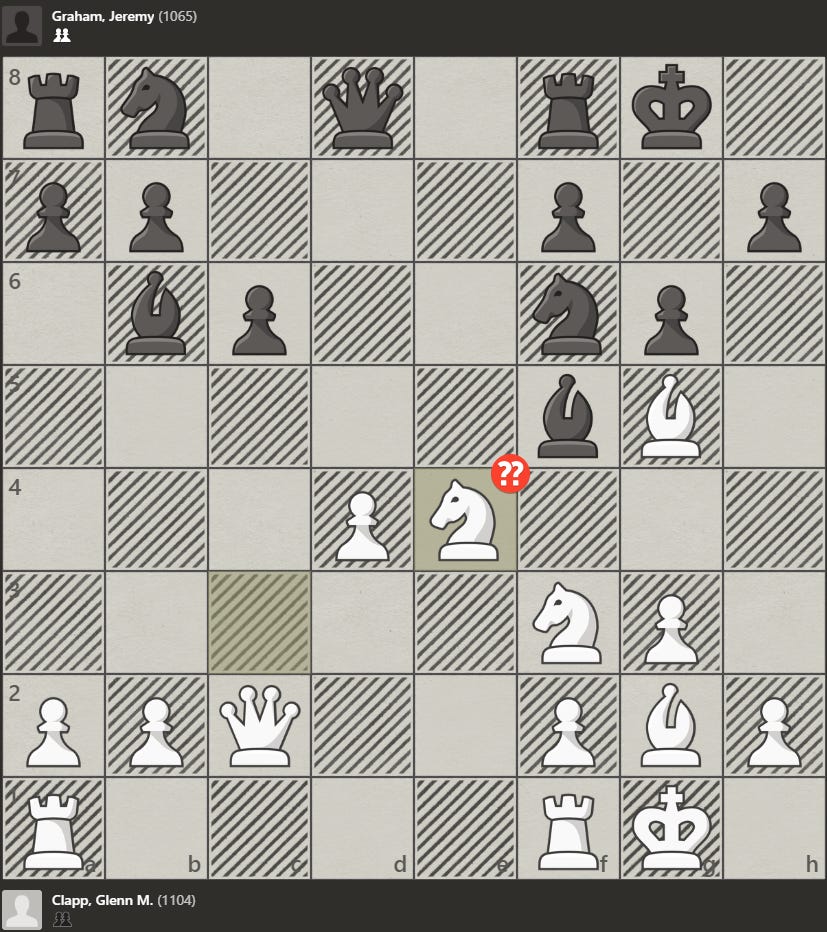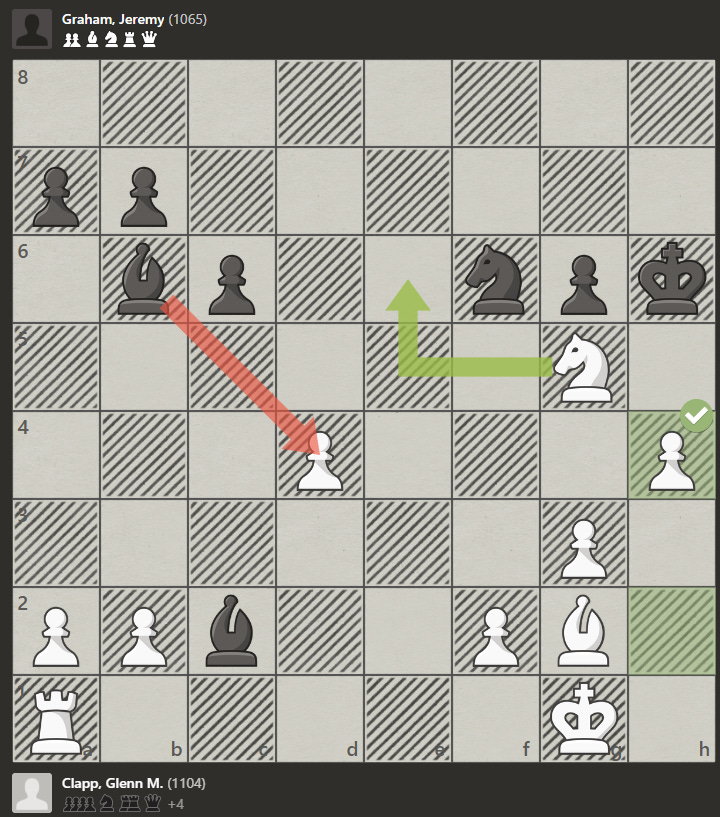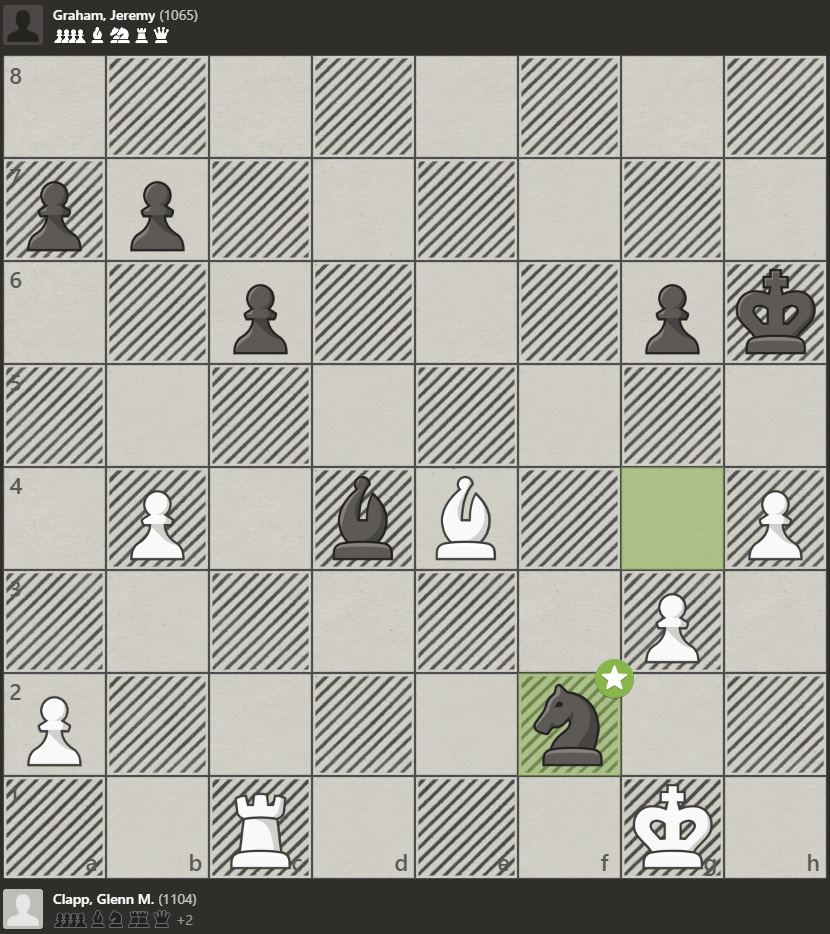The Opening
Jeremy and I will often get together on weekday nights for a game of chess and conversation. This particular game was played on 17 April, 2025, so you won’t see the ratings affected in the table for the tournament on April 15, but you will see my (and Jeremy’s) reflect it in our “starting rating” on the 22nd.
This game was pretty unusual for Jeremy and I. 16/20 games we’ve played have been 1. e4 games, and of those, 10 have been 1. e4 c5 - The Sicilian defense. I was playing white this game though, and I’ve been trying to switch over to The English. Some players, like Elliot, are getting wise to this change… This game started with:
1. c4 e6 2. g3 Nf6 3. Bg2 c6 4. Nf3 d5 5. cxd5 exd5 6. O-O Bc5 7. d4 Bb6 8. Nc3 O-O 9. Qc2 g6 10. Bg5 Bf5 11. e4 dxe4
That’s a lot of moves to just blast through, but they were very standard fare, and very draw-ish for that whole time. But if you want to follow along (and you should, you’ll learn more from the game that way) you can do so on a board of your own in real life, or you can use a digital board like the one found here:
The First Mistake
The first mistake this game was mine, and it was pretty obvious. I took the pawn on e4 thinking that I could win back a piece tactically, and now in hindsight it’s not even clear to me why I thought that.
12. Nxe4??
But, luckily for me, Jeremy kind of let me off the hook this time.
12… Re8
The worst mistake
The worst mistake, and the last mistake, was Jeremy’s. Interestingly, black is still OK here as long as, after the fork, black plays Qxf6. However, any other move loses a full queen.
13. Nxf6+?? (13… Qxf6 14. Bxf6 Bxc2)1
13… Kg7 14. Nh5+ Kg8 15. Bxd8 Bxc2
The rest of the game, my advantage would wax and wane, honestly I expected to find quite a few blunders on my part as Jeremy was able to keep the game very competitive right to the end, but the computer seems to suggest that there wasn’t much going on the rest of the game, and white had a steady advantage of about a rook’s worth of material.
16. Nf6+ Kg7 17. Nxe8+ Kh8 18. Bf6+ Kg8 19. Rfe1 Nd7 20. Nd6 Nxf6 21. Re7 Rd8 22. Nxf7 Rf8 23. Nh6+ Kh8 24. Rf7 Rxf7 25. Nxf7+ Kg7 26. N3g5 h6 27. Nxh6 Kxh6 28. h4?
I really would classify h4 as a blunder personally, even though the computer seems to think it’s fine. Allowing Jeremy to play Bxd4 really through the game into question at the board, and a win felt far from certain.
28… Bxd4 29. Rc1 Bf5 30. b4 Ng4 31. Ne4 Bxe4 32. Bxe4 Nxf2
After 32… Nxf2 we were really at a cross roads (despite the computer’s lack of concern) and the position shown below is the one that Jeremy and I discussed most after the game. It turns out that, as we suspected, there really is only one response that doesn’t let black right back into the game. If you haven’t been following along so far, ensure that you do now, and see if you can find the move for white without peeking!
First, some move that do NOT work.
(33. Re1??) This move loses to Nxe4+. Black takes the bishop, which is not actually defended by the rook because of the discovered check.
And because the bishop on e4 is attacked, no king move succeeds in saving it. Though one king move can save the game by winning a piece in return… foreshadowing…
(33. Bc2??) This move also fails. For while it gets the bishop to safety, and seemingly denies the knight the d3 square, the discovered check strikes again! 33… Nd3+ wins the rook!
There are actually two moves that work, and for similar reasons.
(33. Kg2 Nxe4 34. Rc4 Nxg3 35. Rxd4) This move manages to save the game as it wins a piece (admittedly for a pawn) to make up for the lost bishop and the game is still proceeding to a winning endgame for white.
Much more clean, in my opinion is to play Rc4 right away. And that’s what happened in the game. White immediately wins black’s bishop in exchange for his own, Black only then grabs the pawn on g3, but the difference is, it’s WHITE’s turn in this line.
33. Rc4 Nxe4+ 34. Rxd4 Nxg3 35. Rd7 Nf5 36. Rxb7 Nxh4 37. Rxa7 g5 38. Rc7 g4 39. Rxc6+ Kg5
The game proceeds pretty straight forwardly with white cleaning up a bunch of pawns, and the board being further simplified. Counterplay is becoming less and less likely for black.
40. b5 g3 41. Rc3 Kg4 42. Rc4+ Kh3 43. Rxh4+ Kxh4
And with that forced exchange, black is out of defensive resources and the result is all but inevitable. But Jeremy is a pro, and when he can no longer play for a win, is happy to play for a draw, so I still had to ensure there were no stalemate tricks available to him.
44. b6 Kh3 45. b7 g2 46. b8=Q Kh4 47. Qh2+ Kg4 48. Qxg2+
And once the last pawn was removed from play, and there were no realistic chances for stalemate remaining, Jeremy resigned.
To see an interactable analysis of this game, click here.
Parentheses are used to denote lines that are of interest to the analysis, but didn’t actually occur in the game.





